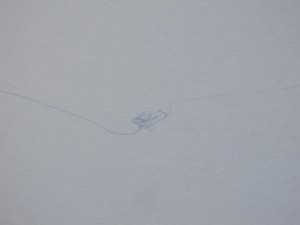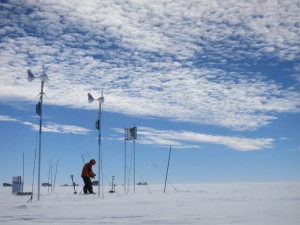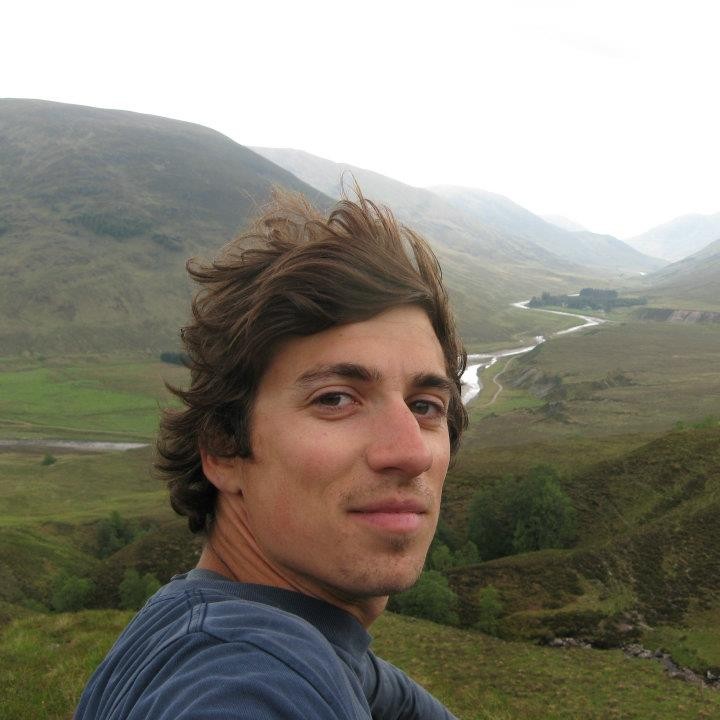The update below arrived today, written by Damon Davies. Damon is a PhD student at the School of GeoSciences, University of Edinburgh. He is working on deep radar measurements through the ice using the DELORES radar for Dynamic Ice (iSTAR C), and has set up his own website and blog at http://daviesdamon.wordpress.com.
With the arrival of the iSTAR C team at Pine Island Glacier the traverse is now at full capacity. Our journey to the field camp site at iSTAR 06 was simply stunning. Our Twin Otter stopped to refuel at Fossil Bluff and Sky Blu field stations passing over nunataks piercing through crevasse scarred ice. As we closed in on the iSTAR camp the footprint of the previous day’s campsite appeared below with tracks of Polar 1 and 2, the traverse snow tractors providing us with a road leading us to their current location.

An abandoned iSTAR field camp seen from the air – nothing but foot- and tractor-prints remain. Photo: Damon Davies.
We skidded to a halt on the skiway and were greeted by the rest of the traverse team followed by a curry in the caboose cooked by Anna. Our first day was spent familiarising ourselves with our mobile home for the next two months and setting up the DELORES (DEep LOoking Radio Echo Sounding) radar equipment that will allow us to see beneath the 2-km thick ice of Pine Island Glacier. Caboose cuisine has far exceeded expectations with each member taking their turn to provide breakfast, lunch and dinner for the rest of the group. This has included homemade burgers, pancakes, chilli bread and a plentiful supply of custard. Not quite the basic rations I had imagined for Antarctic fieldwork but good food fuels good science! The only problem that has so far threatened to derail the entire traverse is a faulty can opener but we battle on against all odds.
Yesterday the new arrivals experienced their first camp move. The rest of the team led by James, Johnny and Tim have this operation down to a fine art with tents packed up, science equipment stowed and everything attached to the snow tractors ready to be hauled to the next location in just a few hours. Travelling between sites in the caboose is a surprisingly comfortable if not slightly bizarre experience being towed over an ice sheet in a compact kitchen/dining room. On arriving at our new campsite at iSTAR 07 everyone set into action constructing the new base. News arrived over the radio from Rothera that Rob had been awarded the Polar Medal for his contribution to polar research so at dinner we toasted to his achievement.

Jan sets up a GPS station, powered by solar panels and wind generators. This station will track the movement of the ice over the next year. Photo: Damon Davies.
With the recent good weather and 24 hours of daylight, science activities have been in full swing around the clock. The iSTAR-C DELORES team have started driving the 15 km radar grid lines, Jan has been busy building GPS stations that will record changes in the flow of Pine Island Glacier, Thomas and Anna have been studying internal ice layers with high-frequency radar and Peter has been continuing his snow density measurements with the Neutron Probe.
Driving back to camp after completing our radar lines this evening, Rob and I observed the camp from afar. As we approached we could see the movement of silhouettes on the horizon, all busy at work collecting their data. It’s great to see such a variety of science taking place. We have a long way to go before completing the traverse route but everything is going well and everyone is eager to crack on.

